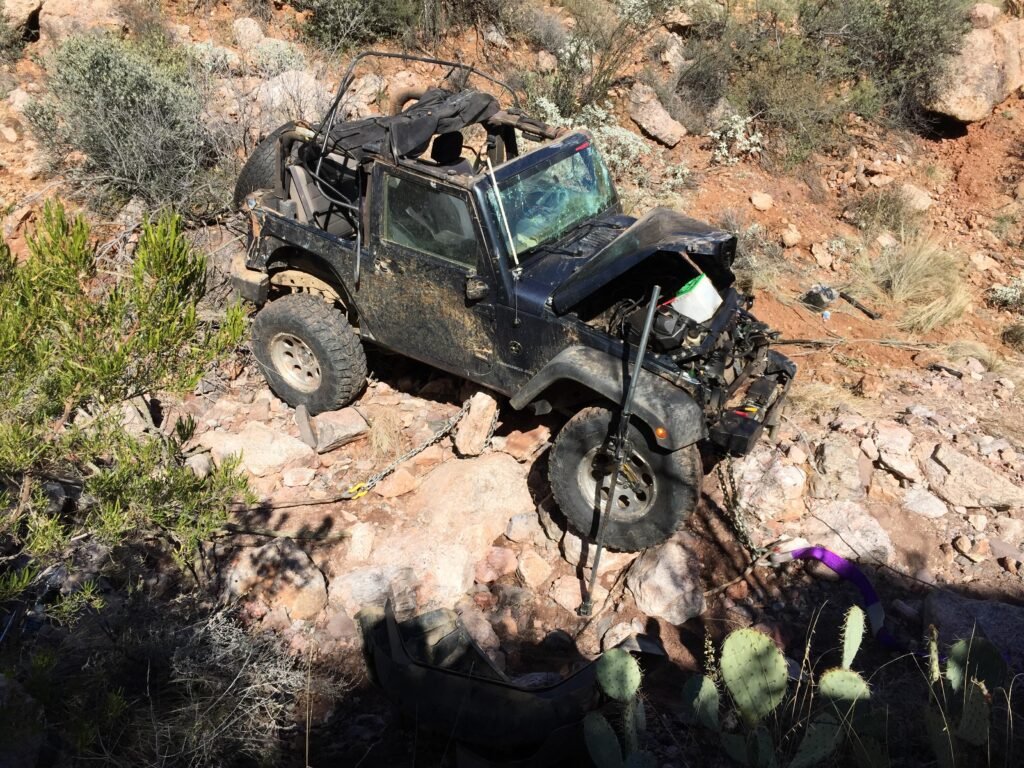Best Steps to a Safe Vehicle Recovery
By Nena Barlow
This article originally appeared on fourwheeler.com.
There are only two types of wheelers: those that have been stuck and those that will be stuck. It can happen through mechanical failure or operator error, but when a rig is stuck, the first thing to do is make sure that the vehicle is stable and the people are safe. It’s natural that everyone involved wants to jump out and rush to be heroic, but safety must come first.
Once any true emergencies have been eliminated (i.e. something is on fire or someone is injured), a vehicle recovery should be executed in a calm, thorough, and systematic manner.
One can find many wonderful articles about different pieces of recovery equipment and how to use them properly and safely. This is all good, but the process of deciding what to use in which situations is critical. In my recovery training courses, we practice IPDE: identify, predict, decide, execute.
Step 1: Identify. Take a visual inventory of everything around, above, and below the vehicle. Why is the vehicle no longer able to move on its own power? What did the driver see, hear, and feel leading up to the vehicle getting stuck? Is it up to its rocker panels in mud with tires spinning? Is the undercarriage wedged on a rock? Did it just run out of gas?
Step 2: Predict. Examine all the possible courses of action to get the vehicle moving again. Look at the space that the vehicle will occupy as it moves during any recovery procedures. In which directions is it possible to move the vehicle given the equipment, situation, and environment?
Step 3: Decide. Determine the course of action you will attempt based on the following priorities. The Safest: Which option provides the least danger to the people involved? The Most Effective: Of the safe options, which is the most likely to work given the equipment and terrain with which you are working? The Easiest: Of the safe and effective options, which one requires the least exertion and strain on both the people and vehicles involved? Are there fewer hazards in moving the vehicle in one direction as opposed to another? Is it better to use a kinetic rope or a static winch? Is there a suitable winch point? Is it better to use a high-lift jack instead of dragging with a rope or a winch?
Step 4: Execute. Once you have decided on your course of action, execute it thoroughly. If, at any step, the process is not going according as predicted, stop, reassess, and start back at the first step.
The people that are the most effective at recoveries are not necessarily the ones who have the most equipment, but the ones who are the most resourceful. The most critical piece of equipment you have is your brain.
Sure, we can just pull out the winch line and drag her over the rock, but what will that do to the driveshafts, evaporative canister, and other things not keen on having the weight of a 6000-pound Jeep on them?
Buried up to the axles, with all four tires spinning in goo. Before we give him a yank, we will try to ascertain whether or not there is anything that might rip his undercarriage while we do so. No one said recovery was a clean job!
We usually recommend trying a static pull first—slow and steady. If that fails, it’s time to hook up the kinetic rope and get some good rubber band action.
Many recoveries are a multi-step process. Here, we have tires off the bead, high-centered on rocks, and teetering on the side of a loose hill. Address each problem in order. In this case the recovery was effected as follows. First, it was determined that tires must be on the wheels for the Jeep to move effectively. This was accomplished by securing the vehicle on the uphill side, and then jacking the rig up and using an air compressor to reinflate the tires on the wheels. Second, more jacking to place rocks under the now reinflated tires to lift the Jeep off of the rocks under the oil pan and axles (while still secured from the other side). Third, pull the vehicle back onto the road.
This complex recovery analysis started by working backwards from where we needed the Jeep to end up—out of the canyon and back on the road. It didn’t take a long process to tell that this one was never going to be moving on its own power ever again, so we worked off of the premise that it would need to be pulled as dead weight from here to pavement.
The first execution of this recovery did not go as planned. As the truck tried to winch itself back onto the road with the front, the back only slid off more with each tap of the winch line. When you only have one winch, but both ends of the truck need to be pulled back up onto the road, a Hi-lift works great as a come-along.
-Don’t forget to take safety precautions for any vehicles assisting with the recovery, too. Each vehicle in the rigging should go through the IPDE steps. In this case, the blue Jeep is secured by a winch line from a second Jeep behind the camera. The white Jeep used a snatch block uphill to effect not only a good angle, but assurance that it wouldn’t be dragged towards the cliff edge.
This rig was on its side. It was determined that once it had weight back on its wheels, it could be pulled back to level ground. This reduced further damage to the vehicle body, and was safer for the driver who didn’t have to get back inside to steer while the vehicle was still unstable.








